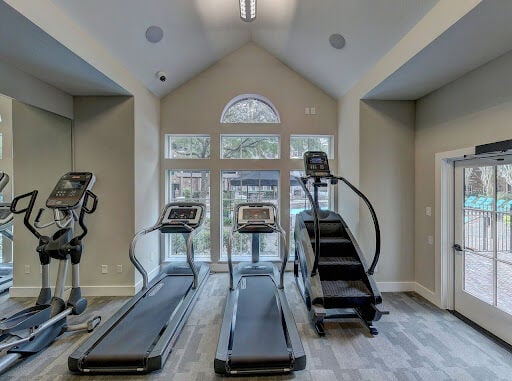
In today's fast-paced world, finding time to hit the gym can be challenging. Many people are turning to home workouts as a convenient alternative. However, creating an effective workout space in a small living area can seem daunting. With some creativity and smart planning, you can transform even the tiniest corner into a functional fitness zone.
The first step in setting up your home gym is to assess your available space and fitness goals. Consider what types of exercises you enjoy and what equipment you'll need. Remember, a home gym doesn't require a full room - even a small area can suffice. Once you've determined your space, think about your workout attire.
Comfortable, breathable clothing is vital for any workout routine. Though you are planning to work from home, proper gym attire is very necessary not only to enhance your performance but also boosts your motivation to exercise regularly. For instance, workout pants provide support and flexibility during various exercises, from yoga to weightlifting.
Also, wearing gym t-shirts made from moisture-wicking fabrics can help keep you dry and comfortable during intense workouts.

Maximizing Your Space
When working with limited space, multi-functional equipment is key. Look for items that serve multiple purposes or can be easily stored. Some space-saving options include:
Adjustable dumbbells: These versatile weights can replace an entire rack of dumbbells, saving significant space.
Resistance bands: Lightweight and compact, these bands offer a full-body workout and can be tucked away in a drawer when not in use.
Foldable exercise mat: Essential for floor exercises, a foldable mat can be stored vertically or under furniture.
Wall-mounted equipment: Consider installing a pull-up bar or resistance bands on your walls to maximize floor space.
Compact cardio equipment: If you have room for one larger piece, consider a folding treadmill or a stationary bike that can be wheeled into a closet.
Creating the Right Environment
Your workout space should be inviting and motivating. Here are some tips to enhance your area:
Lighting: Ensure your space is well-lit. Natural light is best, but if that's not possible, invest in good quality artificial lighting.
Mirrors: A small mirror can help you check your form and make the space feel larger.
Ventilation: Good air circulation is crucial. If possible, position your workout area near a window or use a fan.
Storage solutions: Use vertical space with wall-mounted shelves or hanging organizers for smaller equipment.
Inspirational elements: Add motivational quotes or a small plant to personalize your space.
Making the Most of Your Workouts
With limited space, it's important to focus on efficient workouts. High-Intensity Interval Training (HIIT) and bodyweight exercises are excellent options for small spaces. These workouts require minimal equipment and can be highly effective.
A study published in the Journal of Strength and Conditioning Research found that bodyweight circuit training can significantly improve muscular endurance and reduce body fat percentage. This type of training is perfect for small spaces as it requires no equipment and can be adapted to various fitness levels.
Overcoming Space Limitations

Don't let a small space limit your fitness goals. Here are some strategies to overcome space constraints:
Use your surroundings: Stairs can be great for cardio, while a sturdy chair can be used for step-ups or tricep dips.
Time management: If you can't fit all your equipment in one area, consider rotating pieces based on your workout schedule.
Virtual classes: Many online fitness programs are designed for small spaces and require minimal equipment.
Outdoor extensions: When weather permits, extend your workout to nearby outdoor spaces like parks or your backyard.
Staying Motivated
Maintaining motivation can be challenging when working out at home. Here are some tips to stay on track:
Set a schedule: Treat your home workouts like appointments you can't miss.
Track your progress: Use a fitness app or journal to monitor your improvements.
Join online communities: Connect with others who are also working out at home for support and accountability.
Vary your routine: Regularly change your workouts to prevent boredom and plateau.
Reward yourself: Set goals and reward yourself when you achieve them.
The Impact of a Home Gym on Health and Lifestyle
Creating a home gym, even in a small space, can have significant benefits. A study published in the American Journal of Preventive Medicine found that having exercise equipment at home was associated with higher levels of physical activity. This increased activity can lead to improved overall health, reduced stress levels, and better work-life balance.
Moreover, the convenience of a home gym can help overcome common barriers to exercise, such as lack of time or gym anxiety.
Creating an effective workout space in a small living area is not only possible but can be highly rewarding. With careful planning, smart equipment choices, and a bit of creativity, you can design a functional and motivating fitness area that fits your space and lifestyle. Remember, the best home gym is one that you'll use consistently. Start small, focus on your goals, and gradually build your perfect workout space. Your health and well-being will thank you for it.






(0) comments
We welcome your comments
Log In
Post a comment as Guest
Keep it Clean. Please avoid obscene, vulgar, lewd, racist or sexually-oriented language.
PLEASE TURN OFF YOUR CAPS LOCK.
Don't Threaten. Threats of harming another person will not be tolerated.
Be Truthful. Don't knowingly lie about anyone or anything.
Be Nice. No racism, sexism or any sort of -ism that is degrading to another person.
Be Proactive. Use the 'Report' link on each comment to let us know of abusive posts.
Share with Us. We'd love to hear eyewitness accounts, the history behind an article.